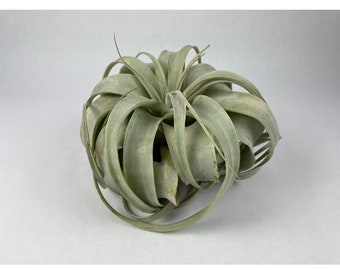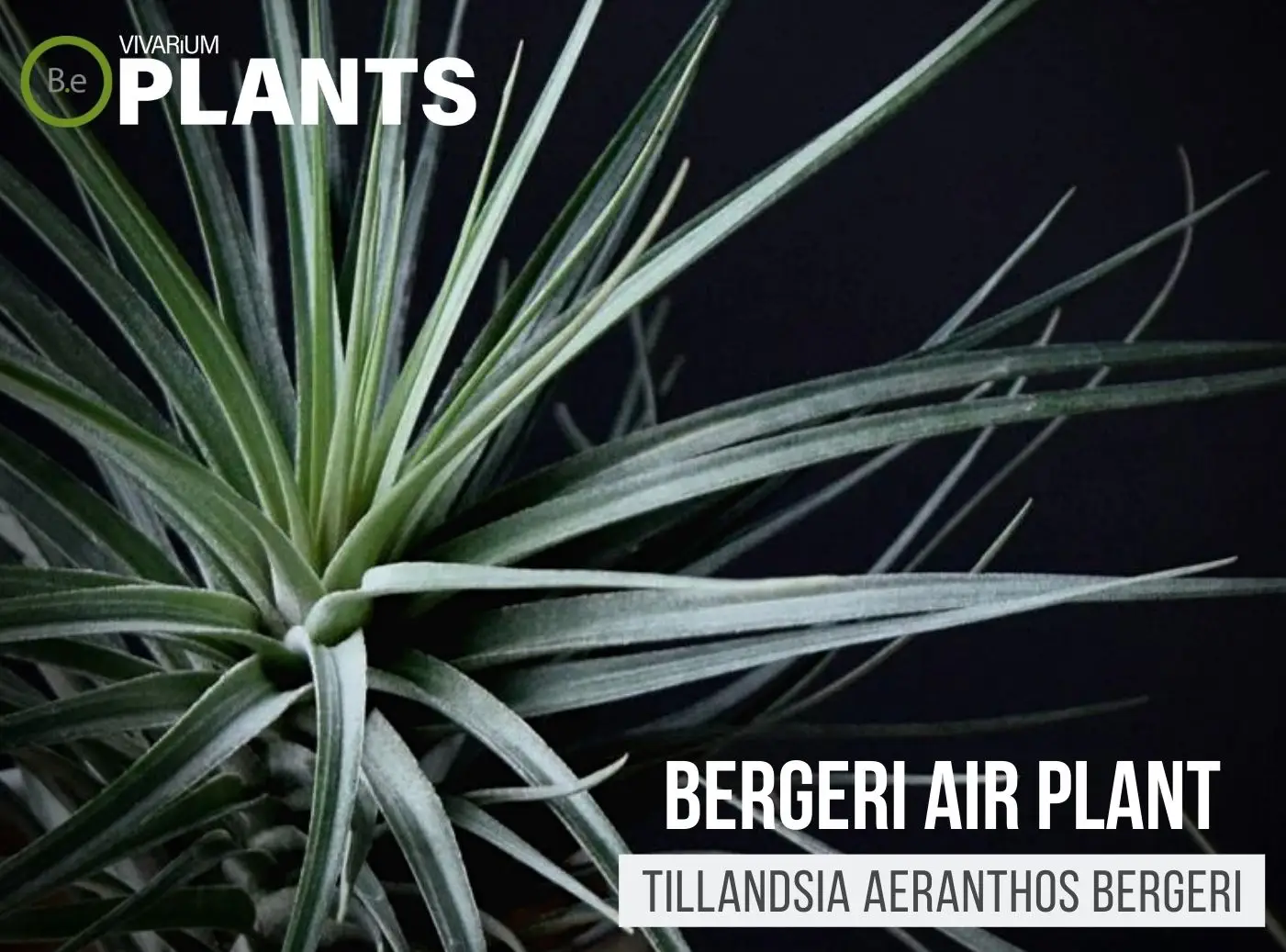Tillandsia xerographica, also known as King of Air Plants, is an epiphytic bromeliad and among the most popular air plants in the Tillandsia genus.
Native to south-central Mexico and Guatemala, this plant is a xerophytic plant, meaning it has adapted to tolerate periods of drought.
Tillandsia xerographica is highly sought after due to its unique foliage, versatility, and easy care needs.
Sustainably harvested and readily available for purchase, every vivarium enthusiast should give King of Air Plants a try.
Table Of Contents:
ToggleWhat is the King of Air Plants?
Tillandsia xerographica is a slow-growing species of Bromeliad that makes an excellent addition to all sorts of homes, gardens, and other types of vivariums.
Because of its adaptable habit, Tillandsia xerographica can work in almost any kind of enclosure.
It features a unique rosette of silvery green leaves, that are stiff and upright.
Tiny white branches of leaves, a bloom of delicate flowers, will eventually grow once the plant reaches maturity.


King of Air Plants Facts
King of Air Plants is a great option for terrariums or vivariums with large terrestrial animals as it’s quite sturdy and can withstand light amounts of handling as well as climbing.
Tillandsia xerographica is a simple epiphytic plant that grows on rocky tree trunks, rocks, and boulders.
While Tillandsia xerographica is slow growing to reproduction, the best method of propagation is to divide the pups.
The new plants will have an identical look to the original.
Description
Tillandsia xerographica is an upright rosette-like formation of green, grey, and silverish leaves arranged around the stem.
Its leaves are wiry and stiff and can look more deeply toned as they mature with silvery stripes running throughout.
As the plant matures, white flowers sprout from the center, attracting unique pollinators like small hummingbirds.
Habitat
Tillandsia xerographica is a tropical plant native to the semi-evergreen woodlands and oak-pine forests of South-Central Mexico and Guatemala.
In the wild, this air plant soaks up moisture from the air.
It also can get its nutrients from whatever organic matter falls from the trees like rotting moss or leaves.
The average temperatures in its native habitat range from the mid-’60s to the mid-90s.
pH Preference
Tillandsia xerographica grows best in slightly acidic soil with a pH range between 6.5 and 7.5.
This plant prefers more neutral soil and acidic levels when grown outdoors.
Vivarium Type
The King of Air Plants is quite an easy-going species.
With that in mind, it will not be too complicated when it comes to choosing the type of enclosure it is grown in.
It is best to try and replicate the plant’s natural habitat as much as possible.
Doing so will make it easier to provide this air plant with its basic needs.
The proper setup and theme of the enclosure will make a big difference to the overall look and health of the plant.
Be sure to choose setups that are moist and high in humidity. Here are recommended vivariums it will do well in:
- Paludariums – Half aquatic/ half terrain-based enclosure.
- Terrariums – Fully terrain-based enclosures with little to no aquatic features.
Vivarium Placement
Tillandsia xerographica is an epiphytic air plant so it doesn’t need to be placed in soil like most vivarium plants.
It can grow on dry surfaces like wood, rocks, cork, and stone.
Try to place this plant in the higher branches to give it more airflow.
Substrate
King of Air Plants can be grown on a range of surfaces including wood, rocks, and cork.
Opt for a drier and firmer substrate without any soil so the plant does not become waterlogged.
Just make sure the substrate has some drainage holes, like a mesh plastic pot, this will help excess water drain out quickly.
Lighting
King of Air Plants requires bright indirect sunlight for optimal growth.
It can also tolerate moderate to full shade but does require good airflow and exposure to a few hours of direct light.
Artificial LED lights or fluorescent fixtures can also provide adequate terrarium lighting when grown indoors.
Buy King of Air Plants
When it comes to buying King of Air Plants, there are a few things to keep in mind.
Making sure the plant is healthy when purchased is essential for its success in a vivarium.
Vegetation that is already in poor conditions will have a very hard time adjusting to new environments.
Click the image below to find out more about the current price and other relative info about this plant.
King of Air Plants Care and Propagation
Tillandsia xerographica is a hardy air plant that is easy to care for and can survive in almost any condition.
As with most air plants, you will only need to mist the plant twice a week and maintain a level of humidity around the plant.
Your frequency of misting may vary depending on the type of vivarium.
Care must be taken not to water-log the plant as it can rot if left in too much water.
How to Grow
For King of Air Plants, it is best to divide an existing mass into individual plants, spraying each pup with water.
You can also propagate new pups, from the mother plant by peeling the air plant off and breaking off the little floaters, spraying them with water, and allowing them to develop roots.
Watering
Tillandsia xerographica should be misted with a spray bottle 1-2 times a week, depending on your vivarium conditions and environment.
Try to allow the plant to dry out completely between misting sessions.
Never submerge your air plant in water as it can cause root rot and that will kill the plant.
Be sure to also mist underneath the Tillandsia xerographica’s leaves as this will allow the plant to get most of the moisture it needs.
Plants Similar to King of Air Plants
Adding diversity to an enclosure is key to an aesthetically pleasing setup.
Try mixing up the look of your vivarium with different flora that can easily co-exist in the same types of environment.
Furthermore, if you find King of Air Plants hard to acquire or would like to consider something similar to this plant…
Here are other terrarium plants you might find will do well with or in the place of Tillandsia xerographica:
Conclusion
King of Air Plants is an excellent choice for any terrarium enthusiast.
What makes it stand out is its unique shape, hardiness, and easy care needs.
It can live in almost any type of vivarium, whether it be a rainforest, desert, or elsewhere.
As long as it receives bright indirect sunlight and misting sessions, it will thrive and look beautiful.
With the right care, you’ll have a pet air plant that will last for years.
Frequently Asked Questions
Yes, Tillandsia xerographica can take full sun. It is a drought tolerant air plant that loves bright, direct sunlight and can even tolerate temperatures up to 95 degrees Fahrenheit.
Yes, Tillandsia xerographica (Air Plants) can be grown indoors as long as they are provided with bright, indirect sunlight, high humidity, and plenty of air circulation.
Signs of a Healthy Tillandsia Xerographica Plant include:
– Vibrant green color
– Strong, healthy-looking leaves
– Fluffy-looking center
– Abundant flowers
– Pliable, thick leaves
– Visible root system
Yes, Tillandsia xerographica can bloom. The bloom consists of a yellow or greenish yellow flower and can occur when the plant is sufficiently mature and the conditions are right.
Tillandsia Xerographica can live up to 25 years with proper care.
A Xerographica air plant can die from a lack of indirect light, incorrect watering (too much or too little), insufficient air circulation, and sudden temperature changes.






